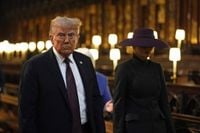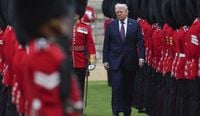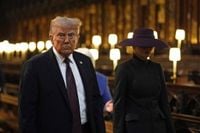On a crisp September morning in 2025, the cobbled grounds of Windsor Castle echoed with the steady drum of ceremonial boots and the hum of anticipation. U.S. President Donald Trump, accompanied by First Lady Melania Trump, arrived for his second state visit to Britain—a rare honor, and one that would unfold with a blend of solemnity, spectacle, and political calculation.
The visit’s most poignant moment came early: a private tribute at St George’s Chapel, where Trump laid a wreath on the tomb of the late Queen Elizabeth II. According to the BBC, the president and first lady spent about ten minutes at the burial site, quietly reflecting before emerging into the nave to listen to a performance by young choir members. The couple then toured the ancient gothic chapel, guided by chapter clerk Charlotte Manley, who oversees the historic site. Trump later described the experience as “a great honour,” telling Manley that the visit was “very special.”
“The meeting with the Queen was incredible. I think I can say I’ve really got to know her because I’ve sat with her many times and we had automatic chemistry. You understand that feeling, it’s a good feeling. But she’s a spectacular woman,” Trump told Fox News, reflecting on his previous interactions with the late monarch. The president’s admiration for Queen Elizabeth II was well-documented, and he often spoke of their “automatic chemistry” and the rapport they developed during his first state visit in 2019.
Yet, as with so many things royal and political, the story is not without its complexities. Author Craig Brown, in his biography A Voyage Around The Queen, claimed that the Queen found Trump “very rude” and particularly disliked his tendency to look over her shoulder, “as though in search of others more interesting.” The contrast between Trump’s fond recollections and the Queen’s purported private feelings adds a layer of intrigue to the narrative, one that captures the nuanced dance of diplomacy and personality at the heart of such visits.
St George’s Chapel itself is steeped in history. Construction began in 1475 under Edward IV and was completed by Henry VIII in 1528. The chapel is the spiritual home of the Order of the Garter, England’s premier chivalric order, and houses the tombs of eleven monarchs—including Queen Elizabeth II, Henry VIII, and Charles I. It’s also the site of major royal events, such as the 2018 wedding of Prince Harry and Meghan Markle, who now reside in the United States. During the tour, the Trumps were shown the plate marking Sir Winston Churchill’s former seat, a nod to the enduring ties between the two nations.
As the choir performed Vivaldi’s “Gloria,” Trump listened intently before joking with the young singers: “See those people over there, they’re gonna make you famous.” The moment, captured by The Independent, offered a brief, humanizing glimpse behind the formality of the occasion—a president sharing a lighthearted exchange with children in a setting heavy with history.
But the day was about more than private moments and royal tradition. The Trumps’ arrival at Windsor Castle was met with the full pageantry of British ceremonial welcome. King Charles III, Queen Camilla, Prince William, and Kate greeted the American president and first lady. A guard of honour stood ready, and the visitors were treated to a carriage ride through the castle grounds, lined by 1,300 British service personnel in scarlet uniforms and bearskin hats. The planned military flypast, featuring UK and U.S. F-35 jets, was described by British officials as the largest ceremonial welcome for a state visit in living memory—a powerful symbol of the defense collaboration between the two allies.
President Trump, a self-described royal fan, seemed genuinely moved by the spectacle. “It’s a very special place,” he remarked upon arrival, according to the BBC. He also expressed pride at being the first U.S. leader—and first elected politician—invited by a British monarch for two state visits, a distinction not lost on either side of the Atlantic.
Yet, outside the castle walls, not everyone was celebrating. Anti-Trump protesters gathered in Central London and among the crowds outside Windsor Castle, voicing dissent against the president’s policies and presence. For Prime Minister Keir Starmer, the visit was a delicate balancing act. As reported by the BBC, Starmer hoped to use the royal allure and Trump’s fondness for the monarchy to strengthen the “special relationship,” deepen economic ties, and secure billions of dollars in U.S. investment—particularly in cutting-edge sectors like artificial intelligence, quantum computing, and civil nuclear energy.
Major American companies, including Microsoft, Nvidia, Google, and OpenAI, have already pledged £31 billion ($42 billion) in British investments over the coming years, a tangible sign of confidence in the UK’s tech sector. Starmer also aimed to make progress on trade, building on an initial deal with Trump to lower certain tariffs. Talks during the visit were expected to address remaining levies on British steel, whisky, and salmon—issues with real economic stakes for both countries.
“They want to see if they can refine the trade deal a little bit,” Trump said before departing the White House for Britain, hinting at the pragmatic negotiations underpinning the pageantry. The agenda also included discussions on pressing global issues, notably the ongoing conflicts in Ukraine and Israel, with Starmer keen to press the U.S. president for continued support and cooperation.
For King Charles III, the state visit offered a moment of international attention unmatched since his coronation. The monarch’s role as host was both ceremonial and strategic, showcasing the continuity of the British crown and its unique power to draw global leaders into its orbit. The planned state banquet, with speeches by both the king and the president, was set to cap a day of tradition, diplomacy, and—perhaps above all—stagecraft.
In the end, the visit was a tapestry of contrasts: solemn remembrance and political calculation, public spectacle and private reflection, warm words and whispered doubts. As Trump and Melania departed St George’s Chapel, the echoes of choir music and centuries-old tradition mingled with the uncertainties of a world in flux. The moment was fleeting, but the symbolism—of history, alliance, and ambition—lingered long after the last notes faded beneath the chapel’s soaring arches.


